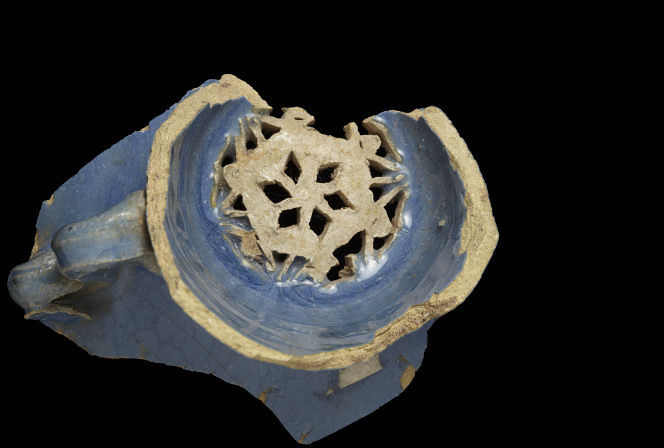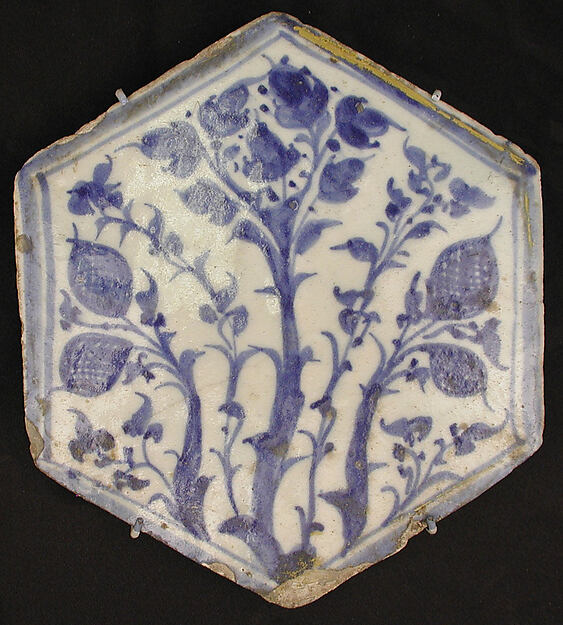Blue on White ceramics: the reciprocal influence of
Chinese porcelain on European and Middle Eastern ceramics - Egypt
Other essays on the history of BoW in Iraq, early Iran, late Iran, Japan, China, Turkey, Spain, The Netherlands, Italy and England.
This brief investigation of blue on white ceramics is focused on Egypt as my previous investigation suggested that the potters of Basra moved to Cairo around the 10th century and the rise of the Mamluks.
This brief investigation of blue on white ceramics is focused on Egypt as my previous investigation suggested that the potters of Basra moved to Cairo around the 10th century and the rise of the Mamluks.
Pre 10th century
The Ancient Egyptians produced some beautiful items
with blue overglaze such as these bowls (1, 2, 3). Over a long period of time, the Egyptians
were producing items such as the iconic scarab in solid blue or turquoise
overglaze (4). This range of blueish-turquoise items is
sometimes call Egyptian blue (copper-calcium-silicate) but others appear to
have been coated in a cobalt glaze the source of which is suggested to be
evaporite deposits. Interestingly, the combination of blue and white doesn't
seem to be culturally attractive and there are very few extant examples from
this time (5).
In the 5th - 7th centuries Egypt was controlled by
the mostly Christian, Copts. Coptic earthenware featuring blue motifs seems to
have consisted of red clay objects that were fired (or dried) and then
decoratively painted. Many jars were painted with lines of text however there
are some examples of figures or patterns. The British Museum collection
contains a number of whole (6) and fragmented items (7) from this period. This decoration method
appears to be traditional in the region as similar ones can be found dating to
the 18th Egyptian Dynasty (8) (1543 - 1292 BCE).
The 7th century saw the Byzantinians fighting a
loosing battle for control of Egypt against the Rashidian Caliphate. The
islamic influence of the Rashidians and later the Umayyadian Caliphate resulted
in the conversion of much of the population. I have yet to find any items with
blue glaze from this period but the Rashidians are important to note as they
established the capital at Fustat (now part of Cairo), near what was Coptic
Cairo. After the Umayyadian Caliphate (the largest Empire in the world at the
time), the Abbasid Caliphate came to power.
10th-13th centuries
The 10th century saw the Baghdad based Abbasidian
Caliphate suffering from internal political strife. Sections of the empire were
breaking away, and trade relationships were fluctuating. Fustat (Old Cairo),
under the Fatamid dynasty, was rising as a political power at this time, resulting
in the shift of production from more marginalized regions of the empire, i.e.
Basra, to Cairo (Attwood). I have found no extant BoW items that
support this theory as there is no evidence of the simple designs employed by
the artists of Basra in items recovered from Egypt. The Egyptians do seem to
have adopted the lustreware first developed in Iraq around this time. It's
possible the lack of local cobalt, the local penchant for turquoise and the
desire for the more decorative lustreware squashed the transfer of the BoW
designs.
In the 10th century common ceramic objects in Egypt
are still being dipped in overglaze before being fired (9) as part of the ongoing traditional decorative
theme. The blues are becoming more varied by the 12th century with the
introduction of a more purplish tint to the glaze (10). This may indicate an iron contamination in
the cobalt source. This shift away from the more traditional lapis or turquoise
colourings may be a result of the Islamic influence or a reduction in
quality/quantity of pigment sources. The blue-purple strainer is an interesting
item because typically these lovely objects are natural clay (11) and rarely glazed. I have found a couple of
extant items that were glazed in turquoise as well (12, 13) indicating the love of this colour is deeply
rooted in the Egyptian potters traditions. It seems that even though more
complex and decorative methods are available, the production of common
household goods such as filters and lamps (14) continued to involve simple glazing
techniques. Lamps are of particular interest because they need to be glazed to
prevent the terracotta from absorbing the oils. Lamps are also a common
household object that would require mass production. Colours range from yellows
(15), to greens and turquoise (16) and the rare blue (17). (side note: I love the pied colour of this
one - 18).
Support for Attwood's suggestion on the move of
Basra potters to Cairo is derived from lustre-ware items (19) recovered from Fustat. Stylistically these
items are very similar to objects produced across the Abbysaid Empire (20) and even imported from Spain (21). This makes identification to a hobbiest like
myself particularly challenging and I initially assumed the stylistic diversity
at Fustat was solely due to their geographic location and the importation of
high-level ceramics. However sherds such as 22 are marked with 'sa' which may be a potters
mark, a workshop or a Fustatian tradition, either way, the item has been identified
as Egyptian in origin. Essays on Islamic ceramics on the Ashmolean
Museum propose that the Basra potters migrated to Egypt bringing the skills of
lustreware. These potter families them migrated to Syria and later spread to
Spain after the fall of the Fatamid dynasty in the 12th century.
10 - Bluish-purple strainer from Fostat, Egypt.
12th century, glazed fritware. Victoria and Albert Museum, item number c.914-1919
13th - 14th century
By the 13th century, the Mamluks had risen to power
in Egypt ousting the Abbysaidians. On a side note: the Egyptian Mamluks seem to
have made the greatest imprint on history, but the Delhi Sultinate was also
controlled by the Mamluks which is often overlooked by hobbies scholars
discussing this period in the middle east. Through the 13th and 14th centuries,
Egypt was an important trading hub connecting the Mediterranean, the Red Sea,
India and the East Indies.
Where the potters of Basra produced stylistically
individual designs which are reasonably easy to identify. If anything, the
potters of Fustat can be most easily identified through the use of solid
Egyptian blue and turquoise glazes. This method of identification
unfortunately, doesn't work for styles that require the use of different
glazes. Items recovered from Fustat have a broad range of stylistic influence
with sgraffito (23), incised and dipped (24) and polychrome underglaze (25) items all being produced from the 10th - 14th
centuries. The position of Fustat as the hub of trade networks allowed local potters
to adopt patterns and techniques from across Europe, the Middle East and Asia.
A good example of this is the black and blue (BBW) items produced in Fustat
during the 14th century (26). Some blue and black fragments have been
recovered from Fustat (27, 28) and the style is quite similar to items
produced in Syria at the time (29, 30)
Blue on White in Egypt
The production of BBW items in Fustat indicates the
potters are conversant with the method of applying a white underglaze, then
decorative elements and a clear overglaze. Sherds of Chinese porcelain (31) have been recovered from Fustat confirming
the transport of such items to Egypt. There is no doubt these items influenced
local designs. Sherds have been recovered that sport chrysanthemum like flowers
(32), ducks (33) and other Chinese motifs (34). A number of sherds have been recovered from
Fustat with patterns are reminiscent of Asian and iznik designs (35, 36, 37, 38, 39, 40). While I would like to wax lyrical regarding
BoW trends in this region, I simply do not have sufficient extant objects to do
so.
As well as the importation and imitation of Chinese
BoW items, the Mamluks were producing BoW tiles (41, 42, 43,
44, 45, 46) very similar to the turquoise and blue hexagonal
tiles being created in Syria with an almost Iznik flavour (47).
45 - Hexagonal Tile, 15th Century, Egypt. The Met
Museum Accession Number 67.69.6
Additional
resources:
A section
on the Abbasiddian potters from a web based teaching course on islamic ceramics
hosted by the Ashmolean Museum. http://islamicceramics.ashmolean.org/Abbasid/pottery.htm
A PDF
article on the Abbasid perception of Chinese Ceramics.
Hallet,
J. 2010 Pearl Cups like the Moon, The Abbasid perception of Chinese
Ceramics. Shipwrecked: Tang Treasures and Monsoon Winds.. eds
Krahl, R. Guy, J. Wilson, J.K. Raby, J. Arthur M. Sackler Gallery, Smithsonian
Institution, pp 75-81
A great scientific paper PDF on the reciprocal influence of Tang China and Abbasid Iraq ceramics.
Wood, N., and Tite, M., (2009), ‘Blue and White – the Early Years : Tang China and Abbasid Iraq compared.’ Transfer : The Influence of China on World Ceramics. (Colloquies on Art & Archaeology in Asia No. 24. Percival David Foundation of Chinese Art. ed. Stacey Person, ed. London University, pp 21-45
A short
article on Basra's Potters and their developments
Attwood,
R. 2005 Basra's Inventive Potters. Archeology Reviews.
Vol 58, 2.
A PhD
thesis I'd really like to get my hands on, scientific analysis of the origins
of cobalt.
|
||||||
Wen, R.
2012. The cobalt blue pigment used on Islamic ceramics and
chinese blue-and-white porcelain. PhD Thesis, University of
Oxford.
|
||||||
My
collection of BoW images mapped to location of creation. Note:
only 80 items initially load, you need to scroll to the end of the collection
before they'll all show up on the map. Zoom into your area of interest to see clusters around centers of production.


No comments:
Post a Comment